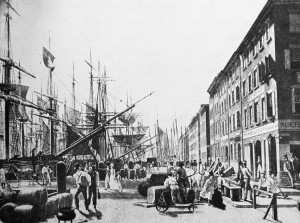Today is the first day of classes at Avenues, the new “world school” whose campus is located in a stately former warehouse on Tenth Avenue between 25th & 26th Streets. Over the next few years the school, a for-profit venture conceived by Benno Schmidt (former head of Yale University) and Christopher Whittle (founder of the Edison Project), will open additional campuses in Beijing (2014), Sao Paolo (2015) and London (2016).
A hallmark of the internationally-focused school is multilingualism. What’s unusual about the language approach is that Avenues is committed to making every student fully bilingual within seven years. If you walk through the new building you’ll see that every bit of signage, from elevators to bathrooms, is written in English, Spanish and Mandarin.
Like many people who spend a lot of time on the High Line, I watched the renovation of the old warehouse with great interest. When I was writing my book I did a bit of research into the R.C. Williams Company, the wholesale grocer that commissioned it, but as the renovation neared completion I found myself eager to learn more. With luck I discovered a company history, published in 1936, and it turns out that this firm has a long and rich history as innovators in the wholesale food industry. But the thing I found most intriguing, given the present use of the warehouse, is that from its very first days, beginning in 1809, R.C. Williams was a global enterprise.
The company history explains that a dealer in food in the early 1800s was perforce an importer because “he could hope to sell his neighbors in New York only those things they could not produce themselves.” Back of the city “lay woods into which a man could always go and shoot quail, wild turkeys, deer.” But he couldn’t get a banana or a pound of coffee. So in the first decade of the 19th century R.C. Williams imported such items as cane sugar, rum, molasses, coffee, salt, pepper, cinnamon, rice and spices; bananas, oranges, wines, ales, brandies and liqueurs; French bonbons, dates and raisins.
And they were notably proud of their global reach. “Our pride in the year 1811,” the history recounts, “was our fleet of tall clippers, our lines of packet ships, which sailed out of New York to all the oceans. In the tea races to China they defeated the fastest vessels of the British, the French and the Dutch. We were in many ways sovereign of the seas.”
Over the years, executives at R.C. Williams opened markets around the globe, and by the turn of the century had became the original “supermarket to the world.” To Argentina they shipped canned corn on the cob and shrimp; to South America, sauerkraut; to Peru, powdered sugar; to the Netherlands, canned oysters and brown bread. Oats went to Palestine and maple sugar and table salt to Germany. The Greeks got pimentos, American rye whiskey, and canned sweet potatoes.

A.P. Williams, CEO, shaking hands with President Williamson of the New York Central Railroad, on the warehouse loading dock, August 1, 1933
I knew that R.C. Williams had hired Cass Gilbert, the great Modernist architect, to design its warehouse, and I also knew that it became the very first client of the New York Central Railroad’s brand new High Line on August 1, 1933. What I hadn’t realized until I read the company history is that this was the second time this firm had put itself at the crossroads of an innovative transportation technology.
Founded just two years after Robert Fulton’s steamship Clermont launched a revolution in New York Harbor in 1807, the R.C. Williams company located its first warehouse on South Street, in spitting distance of Fulton’s Ferry. Clearly the founders understood what Fulton’s technological innovation heralded, and they were right; by 1815, just eight years after the steamship’s maiden voyage, New York City surpassed Boston in maritime trade. The Erie Canal opened up the western part of the country to trade in 1825, and by 1830 New York City had become the preeminent port in the United States.
So today, almost 80 years after the first locomotive pulled up to the loading dock of the global grocer, the “world school” opens its doors with the promise to look outward to the culture and history of nations and peoples all over the globe.
A few years before this warehouse opened Cass Gilbert accepted the Medal for Architecture from the Society of Arts and Sciences. “My plea,” he said in his speech, “is for beauty and sincerity, for the solution of our own problems in the spirit of our own age illuminated by the light of the past; to carry on, to shape new thoughts, new hopes, and new desires in new forms of beauty as we may and can; but to disregard nothing of the past that may guide us in doing so.”
With that I say, Welcome to the ‘hood, folks at Avenues.












Thanks for sharing that on FB. It was fun reading that. Some things I knew from reading Rutherford’s novel ‘New York’
Always interested to learn what happened in the past and what will be happening in the future . I don’t read that much about Chris Whittle anymore. Glad to hear he is well.
Many thanks Annik for the shout! We couldn’t be happier to move into the neighborhood. Thanks for sharing your expertise on the High Line with us, and we look forward to joining you in further studies and explorations of the area. Keep up your great work!
PS Shame we can’t shoot quail in the backwoods anymore.